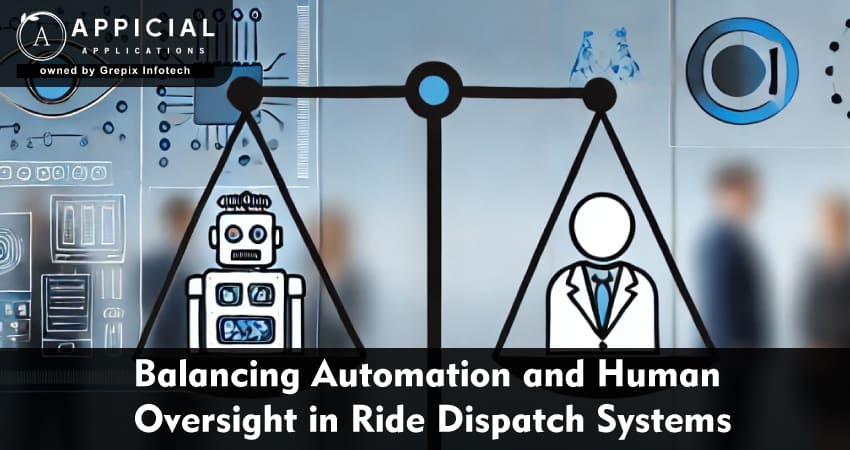
Balancing Automation and Human Oversight in Ride Dispatch Systems
Ride dispatch systems are the backbone of modern mobility services. Automation has fundamentally changed the process of assigning, matching, and managing rides. AI and predictive algorithms play a role in driver assignments, fare estimates, and traffic management by apps such as Uber Clone, ride sharing app, ride hailing app, and e-hailing app.
But technology cannot replace human judgment in its totality. Humans ensure that things are fair, reliable, and of quality. Supervisors step in during bizarre situations, complaints, and safety. Integrating automated systems with humans forms a hybrid system that increases efficiency and minimizes errors.
A white label taxi booking app can incorporate dashboards and override options for human supervisors. Similarly, a white label taxi app development company or a full-service taxi app development company ensures the system is flexible and responsive.
Hybrid ride dispatch systems are essential for modern mobility. This article explores how Uber Clone, ride sharing app, ride hailing app, and e-hailing app platforms balance automation with human oversight. It discusses real-time ride allocation, predictive routing, surge pricing, dashboards, and supervisory roles. We cover challenges, best practices, and metrics to track. Selecting a white label taxi booking app or an experienced taxi app development company ensures seamless operations. The article also addresses FAQs about hybrid ride dispatch systems.
The Role of Automation in Modern Ride Dispatch Systems
Automation drives speed and efficiency. A ride-hailing app can process thousands of requests simultaneously. Algorithms then pair drivers and passengers based on variables such as proximity, traffic, and car type.
Key Benefits of Automation
- Rapid Ride Allocation: waiting time for virtual riders is a few seconds.
- Optimized Driver Matching: Riders matched with relevant drivers.
- Scalability at Peak-Time: Can automatically respond to peaks without any lag.
- Predictive Routing: Understanding where and when the traffic will be.
- Dynamic Pricing: Fares and driver incentives are calculated in real-time using algorithms.
- Data Analytics: Collects ride data to improve performance.
Automation increases operational efficiency in Uber Clone, ride-sharing app, ride-hailing app, and e-hailing app platforms.
Limitations of Automation
- Try/Catch Exception Handling: Factors such as weather, accidents, and roadway closures are left to a person's judgment.
- Customer Complaints: Need to manually resolve fare disputes or driver issues.
- Algorithm Bias: Algorithms can be poorly designed to favour certain drivers or locations.
- Technical Failures: Problems with the network or the app crashing, need humans to solve them .
Automation ensures speed and consistency, while a human ensures that the system is responding appropriately in the real world.
Importance of Human Oversight
Quality and reliability are monitored by a human supervisor. They also monitor dashboards and anomalies, and step in when automation fails.
Key Roles of Human Oversight
- Exceptions Management: Handle ride cancellations, complaints, or wrongly assigned rides.
- Driver Management: New driver approvals, license checks, and driver performance monitoring.
- Quality Assurance: Analyze ride ratings and reviews from users.
- Crisis management: Organizing drivers’ reactions to accidents or breakdowns.
- Customer Satisfaction: Quick rider issue resolution leads to higher loyalty.
A company developing taxi applications system is human supervised automated dispatching system. A white label taxi app development company provides built-in dashboards and alerts for real-time monitoring.
What are the Core Components of Hybrid Ride Dispatch Systems?
Human-supervisory hybrid systems are partially automated systems in which a human retains authority. They assign rides and handle exceptions efficiently.
Real-Time Data Integration
For instance, a ride-hailing app would need to combine information about GPS locations, traffic, driver availability, and ride requests. Routine tasks are automated. Human beings, therefore, track for abnormality and intervene when appropriate.
Predictive Modeling
Models are built for peak demand, areas with high probability of service being requested, and dynamic pricing. Supervisors double-check the predictions and calibrate the thresholds to be safer and fairer.
Dynamic Pricing and Surge Management
Fares are automatically computed by an algorithm. There is human oversight to ensure that pricing is fair, that there are no complaints, and that people will continue to trust the company.
Customer Support Integration
Even automated ride hailing applications need human support. Complaints, cancellations, and emergency ride requests are dealt with by supervisors. It further builds trust and leads to retention.
Dashboard Monitoring
The dashboards enable human oversight of the fleet, manual ride requests, and the ability to stop surge pricing when appropriate. It is then a flexible system in which automation and human intervention can operate together.
What are the Challenges in Balancing Automation and Human Oversight?
Over-Reliance on Technology
Relying entirely on automation can be risky. Critical edge cases, like accidents or traffic jams, may be missed. Human intervention remains essential.
Maintaining Consistency
Humans may make subjective decisions. Standardized procedures ensure uniformity across shifts. This helps maintain service quality.
Integration Complexities
A ride-sharing app connects multiple systems: payment gateways, mapping APIs, and driver apps. Misalignment between automated and human workflows can cause delays or errors.
Data Privacy and Security
Hybrid systems must secure sensitive data. Supervisors need controlled access to prevent misuse. A taxi app development company ensures secure data handling.
How Automation Improves Efficiency
Automation reduces dispatch time, optimizes routes, and minimizes idle driver time. Surge pricing adapts dynamically to demand.
For example, an Uber Clone can automatically assign nearby drivers during peak hours. However, unusual requests or low-density areas require human intervention.
Efficiency Metrics
- Average dispatch time
- Ride completion rate
- Driver idle time
- Surge area accuracy
- Customer satisfaction scores
A white label taxi booking app allows human supervisors to monitor these metrics in real time.
How Human Oversight Enhances Customer Experience?
Human supervisors ensure riders receive prompt assistance. They monitor driver behavior and maintain vehicle standards.
Even automated ride hailing apps benefit from human support during disputes, emergencies, or system failures. This improves trust, retention, and ratings.
Implementing a Balanced Dispatch System
1 Define Automation Scope
Assign predictable, repetitive tasks to algorithms. Reserve exceptions and edge cases for human review.
2 Create Oversight Protocols
Develop guidelines for supervisors. Train them to handle emergencies, disputes, and unusual events.
3Integrate Dashboards
Include live monitoring, alerts, and override options. Supervisors can quickly adjust rides, routes, and surge pricing.
4Continuous Feedback Loop
Insights from human interventions feed into algorithms. Predictive models and pricing logic improve over time.
5 Regular Audits
Compare automated outputs with human interventions. Adjust parameters to improve accuracy, fairness, and service quality.
Also Read: Smart Ride Cancellation Policies: Keeping Riders Happy and Drivers Productive
Future of Hybrid Dispatch Systems
The ride dispatching of the future should be a combination of AI-driven automation and human supervision. Over time, AI will allow for “smarter,” “faster” algorithms to handle the mundane task of assigning rides. Everything from demand prediction and route optimization, fare calculation and surge pricing management will be automated more and more. This will greatly reduce costs and enhance efficiency for Uber Clone, ride sharing app, ride hailing app, and e-hailing app type platforms.
Human supervision will be nonetheless of great importance. Not all situations can be addressed by automation. Supervisors will still step in quality assurance to ensure rides are in a safe and service fashion. When there are accidents, or network outages, or anything else, humans intervene and the problems are solved in a timely manner. Plus, “human oversight will be critical to maintain levels of customer satisfaction, to track driver performance levels, and to manage cases in which automation fails to successfully resolve a customer issue”.
Next-generation hybrid dispatching systems will be smarter and more adaptive. These features will include real-time traffic updates and predicting analytics as well as insights on the riders to enhance the accuracy of automated decision making. On the other hand, humans will concentrate on supervision, intervention when necessary, and tweaking algorithms for a better performance.
These hybrid models will form a larger part of platforms like Uber Clone, ride sharing app, ride hailing app, and e-hailing app. Automation will provide speed and scale, while humans will provide the reliability, trust, and safety. This hybrid model will eventually be the norm for the quality’ mobility services. By augmenting human operators’ empathy and judgment with the speed of AI, it will increase efficiency but also ultimately create a user base that has greater long-term trust in the system.
Conclusion
Striking a balance between automation and human control is vital for ride dispatch systems. Automation offers advantages in speed, efficiency, and scalability. Only humans can maintain fair, quality, and reliable outputs.
Hybrid systems are used by Uber Clone apps, white label taxi booking apps, ride sharing app, ride hailing app, e-hailing app, and others. A good taxi app development company or a white label taxi app development company will ensure the right integration and dashboards and security monitoring.
Appicial Applications focuses on hybrid ride dispatch systems. Their approach leverages the automation capabilities of AI, combined with human oversight. Monitoring live is possible thanks to admin dashboards. Dispatch is optimized by predictive algorithms and is supervised by humans in cases of exceptions.
When you want to develop an Uber Clone, ride sharing app or ride hailing app you should contact Appicial Applications to improve efficiency, reliability and customer satisfaction. So, what are you waiting for? Make this move now and develop a dispatch for excellence.
FAQs
Author's Bio

Vinay Jain is the Founder at Grepix Infotech and brings over 12 years of entrepreneurial experience. His focus revolves around software & business development and customer satisfaction.
Back to blog list




